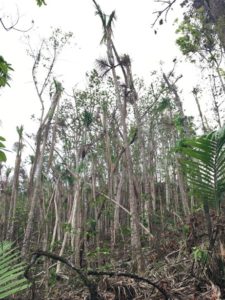Using computer models and field data, researchers found that tropical forests recover from major hurricanes, as long as they are infrequent.
The Science
Scientists use computer programs called ecosystem models to predict and study the future of tropical forests. However, existing ecosystem models do not account for damage caused by hurricanes. This is a problem as hurricanes are becoming stronger because of climate change. A team of scientists modified one ecosystem model so it could simulate hurricane damage on tropical forests. They also used data from a forest in Puerto Rico to test and improve the ecosystem model predictions. Once the model results look good, they tested how long it takes for tropical forests to recover from hurricane damage.
The Impact
The ecosystem model agreed well with the observed forest damage from hurricane Hugo, and how fast forests recovered from the hurricane. The research team tested how long it would take for damaged forests to look similar to forests that never suffered any hurricane damage. To their surprise, damaged forests could accumulate more carbon than undamaged forests. This happened because hurricanes killed many small trees, so large trees grew even larger. These results indicate that infrequent hurricanes may have little impact on forests. With this model, researchers can explore other effects on forests resulting from changes in hurricane frequency and strength.
Summary
To develop the ecosystem model, the research team accounted for three observations. First, trees die much more when hurricane winds exceed 90 miles an hour. Second, hurricanes cause more damage on forests that have only a few large trees. Third, palms are more resistant to hurricane damage than trees. The team used data from the Luquillo Experimental Forest (Puerto Rico) to validate the model. The model correctly simulated the widespread loss of trees following hurricane Hugo. The model also represented well the forest growth and changes in tree and palm abundances over the following 30 years.
The team used the validated model to study the long-term impacts of hurricane disturbances. The team conducted three simulations: one without any hurricane damage, one with severe damage similar to Hugo, and one with moderate damage similar to Maria. The model predicted large losses of biomass immediately following the hurricane disturbances. However, after 80 years since the hurricane, the damaged forests recovered. Surprisingly, forests damaged by hurricane Maria showed 5% more biomass than undamaged forests. This result occurred because the hurricane killed small trees, which reduced the competition for light and water and allowed surviving trees to grow larger.

Contact: Marcos Longo, Lawrence Berkeley National Laboratory, mlongo@lbl.gov
Rafael L. Bras, Georgia Institute of Technology, rbras6@gatech.edu
Jiaying Zhang, Georgia Institute of Technology, jiaying.zhang@gatech.edu
Funding
This research was supported by the National Science Foundation; the K. Harrison Brown Family Chair; the Next Generation Ecosystem Experiments-Tropics, funded by the U.S. Department of Energy, Office of Science, Office of Biological and Environmental Research; the NASA Postdoctoral Program, administered by the Universities Space Research Association under contract with NASA; and the U.S. Department of Agriculture, Forest Service, and the USDA Forest Service International Institute of Tropical Forestry works in collaboration with the University of Puerto Rico. The research carried out at the Jet Propulsion Laboratory, California Institute of Technology, was under a contract with the National Aeronautics and Space Administration.
Publications
Zhang, J., R. L. Bras, M. Longo, T. Heartsill Scalley (2022), The impact of hurricane disturbances on a tropical forest: Implementing a palm plant functional type and hurricane disturbance module in ed2-hudi v1.0. Geosci. Model Dev., 15 (13), 5107–5126. https://dx.doi.org/10.5194/gmd-15-5107-2022